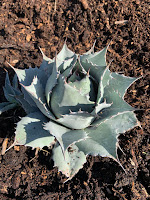 Summer has given way to fall, but if you've lived in the Bay area for long you'll know now is the driest time of year. The gardens are parched and the ground is dusty dry, and we have watered a few plants (new tree Aloes, and a palm we planted) but some plants love the heat. Agave is one genus that thinks the hotter the better!
Summer has given way to fall, but if you've lived in the Bay area for long you'll know now is the driest time of year. The gardens are parched and the ground is dusty dry, and we have watered a few plants (new tree Aloes, and a palm we planted) but some plants love the heat. Agave is one genus that thinks the hotter the better!
We did have some weird weather recently that some agaves didn't love though. A hot dry spell, followed by foggy, smoke-laden air, leads to some agaves ending up with edema scarring.
These mottled marks on some leaves are caused by water being pulled up to the leaves during hot weather, but stopping in its tracks when cool, humid weather hits. The cells loaded with water then burst and scar the leaves. Unfortunate, but the plants will eventually grow new leaves.
We had a lovely September volunteer day, with
Chris, Josh, Matt, Hilary, John and
Andrea generating 18 bags of green waste for recycling! We got lots of plants cut back (the cardoon,
salvias, euphorbias and so on) and turned and watered the compost.
We also planted some great agaves that Matt and I have been growing. Josh put in three Agave maximiliana... or they might be Agave zebra. Except both of these species are supposed to be solitary and this one pups like mad...We will just have to wait and see what they turn into.
Josh also planted a group of seven Agave desmettiana variegates behind the wrong way sign. That area has become a huge farm for baby agaves but we hope to reorganize the plants, put them in groups, and make something pretty out of it all soon.
Matt and I visited with the famous Brian Kemble of the Ruth Bancroft Gardens the following week, and had a blast weeding his pots of hybrid
Agaves, Aloes and
Gasterias while talking about all the cool plants he has grown and known.
In exchange he gave us some lovely plants for the garden, including three Aloe polyphylla hybrids which we planted right away on the lower pathway where they will hopefully thrive. Matt added five more Agave desmettiana variegates in that area too, as well as a few on the way to the tool trunk.
A week later Matt and I were back at the garden, planting yet more
Agaves we have been growing on at home. We did two groups of
Agave gypsophylla up in the top area of PG, and a group of three Yucca aloifolia "Magenta Magic" down at PRG.
It's great to get some plants out of our home garden and into the public gardens - it can take years to grow something big enough to plant out in a street park (small plants tend to get stolen, or crushed) and I feel now that 3-5 gallons is the minimum if possible.



















































